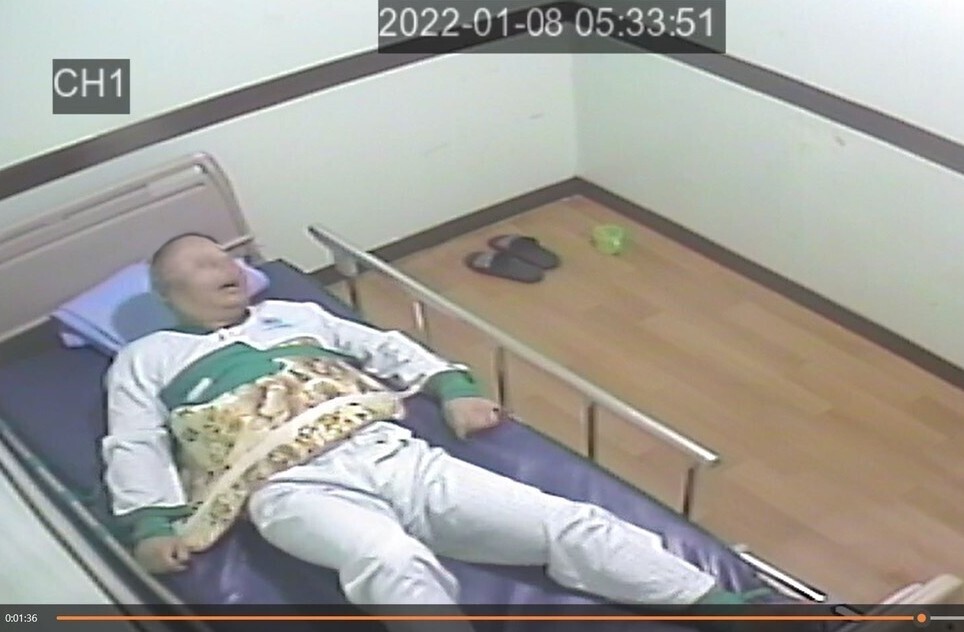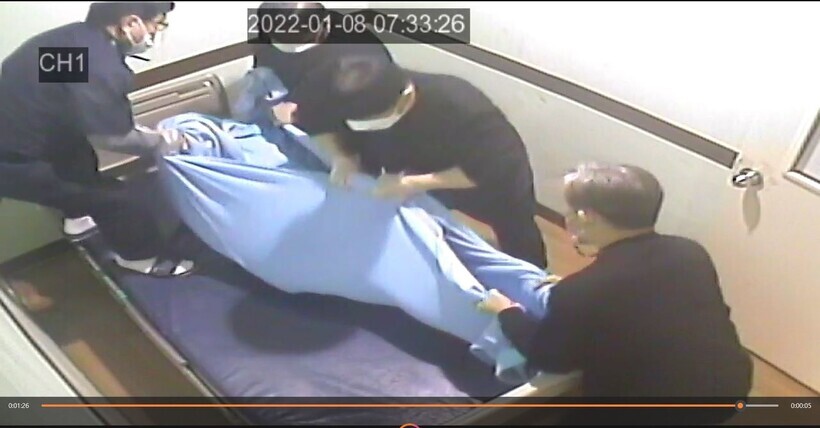hankyoreh
Links to other country sites 다른 나라 사이트 링크
10 days of torture: Korean mental patient’s restraints only removed after death

Editor’s note: His hands, feet and chest were tightly bound. He was strapped to the bed as if nailed to a crucifix. But no salvation awaited the man at this small mental hospital in Chuncheon, equipped with only 299 hospital beds. CCTV footage obtained by the Hankyoreh shows the patient slowly suffering, crying out and moaning in pain, until his death. Not the doctors, nor the nurses, nor the orderlies did anything to save him. All the people who appear in the footage only look like accomplices who facilitated the patient’s death.
A psychiatric hospital is a place for treating psychiatric conditions. But even today, there are such hospitals where the actions labeled as “treatment” border on torture, including restraining or neglecting patients. The Hankyoreh uses CCTV footage to expose the conditions of seclusion and restraint at psychiatric hospitals and explore possible alternatives.
At 7:33 in the morning, the man was carted off after being rolled up in a blanket by four orderlies. Watching the footage felt something akin to watching a piece of meat being wrapped up and shipped off. By the time his restraints were undone, he was already dead.
He had been lying in the solitary room for over 10 days at that point, with his hands, feet, and chest bound to the bed. In the now silent and empty room, only the blinking light of the closed-circuit cameras could be seen.
Only two hours earlier, he had still been alive. Indeed, he had been fighting desperately to stay alive.
At 5:34 am, he tried to lift his upper body. Unable to do so, he let out a scream. At 5:42:57, he began moving his mouth to speak. He continued talking to himself as his stomach rose and fell with his breaths.
A nurse had stopped by 10 minutes earlier, at 5:33 am, but no actions were taken in response to the man’s complaints. The man could only raise his head and watch the nurse walk out of the room.
On the morning of Jan. 8, 2022, a man with no non-psychiatric conditions died in a seclusion room in the isolation ward of a psychiatric hospital in Chuncheon. Forty-five-year-old Kim Hyeong-jin — a pseudonym for the purposes of this article — was placed in isolation in five-point restraint, with both hands, both feet, and chest bound.
Kim, who was admitted to the ward in an emergency hospitalization, was restrained on his bed for 251 hours and 50 minutes of his 289 hours and 20 minutes of hospitalization before eventually dying.
For nearly two and a half years, the rest of the world remained unaware of his death. This was the result of a thorough cover-up by the hospital and a half-hearted investigation by police.
Without the permission of Kim’s family, the hospital had his remains relocated to a refrigerated chamber in a mortuary 23 kilometers away. Two hours passed before his family was notified of his death.
Police responding to a report of the death took only three-and-a-half hours to close the case, determining it to be a “death as a result of illness.” Kim’s family members filed accusations of professional negligence resulting in death against four of the hospital’s medical staff. Seven months later, the police closed the case without pressing charges.

On Monday, the Hankyoreh analyzed 4,067 closed-circuit videos (67.1 GB in all) obtained through Kim’s family. The footage showed him being tied to his bed a total of five times, with his first restraint period lasting 78 hours and 30 minutes.
According to Ministry of Health and Welfare guidelines for isolation and restraint, the maximum period for which a patient aged 19 years or older can be restrained at one time is four hours, with allowances for up to eight hours if the patient must be restrained twice consecutively.
Despite being restrained for periods beyond what the regulations allow, Kim did not receive proper nursing and relief measures. Indeed, the hospital only increased the duration of his restraint periods. Kim ultimately died during his fifth round of being restrained, which had been going on for 66 hours and 50 minutes.
This was not the first case of a psychiatric hospital patient dying while under restraint.
In 2005, a patient in their 50s died after having been restrained for 124 hours straight. In 2013, another patient in their 70s died after being restrained for 17 hours. A case in 2017 involving a patient in their 20s who died after 35 hours of restraint turned into a social issue at the time.
But Kim’s case marks the first time that a family’s efforts have unearthed video footage showing the grisly details of such a death at a psychiatric hospital.
After previously concluding that there had been no issues, the police only took action after an investigation request from the National Human Rights Commission of Korea, which resulted in eight nurses being referred to prosecutors in March for violations of the Medical Service Act. The hospital director, the attending physician, and the doctor on call at the time were not included in the referral.
The Chuncheon District Prosecutors’ Office made a summary decision in April to fine the eight nurses 300,000 won (US$216) each. This was upheld in court the following June. The message sent was that the crime was minor enough in nature for those responsible to be sentenced to small fines without a formal trial.
“Looking at the closed-circuit footage, you could see that the hospital was the scene of a murder,” said Kim’s widow.
“Yet nobody was really punished for it,” she added.
The deceased’s 21-year-old son plans to lodge homicide accusations against the hospital director and attending physician. The Ministry of Health and Welfare recently requested that the government of Chuncheon, which bears responsibility for monitoring and oversight for hospitals in its jurisdiction, reopen the investigation into the case.
By Koh Kyoung-tae, senior staff writer
Please direct questions or comments to [english@hani.co.kr]

Editorial・opinion
![[Column] How tragedy pervades weak links in Korean labor [Column] How tragedy pervades weak links in Korean labor](https://flexible.img.hani.co.kr/flexible/normal/500/300/imgdb/original/2024/0703/8717199957128458.jpg) [Column] How tragedy pervades weak links in Korean labor
[Column] How tragedy pervades weak links in Korean labor![[Column] How opposing war became a far-right policy [Column] How opposing war became a far-right policy](https://flexible.img.hani.co.kr/flexible/normal/500/300/imgdb/original/2024/0702/5017199091002075.jpg) [Column] How opposing war became a far-right policy
[Column] How opposing war became a far-right policy- [Editorial] Korea needs to adjust diplomatic course in preparation for a Trump comeback
- [Editorial] Silence won’t save Yoon
- [Column] The miscalculations that started the Korean War mustn’t be repeated
- [Correspondent’s column] China-Europe relations tested once more by EV war
- [Correspondent’s column] Who really created the new ‘axis of evil’?
- [Editorial] Exploiting foreign domestic workers won’t solve Korea’s birth rate problem
- [Column] Kim and Putin’s new world order
- [Editorial] Workplace hazards can be prevented — why weren’t they this time?
Most viewed articles
- 1Car behind deadly crash began rapid acceleration after exiting underground garage
- 210 days of torture: Korean mental patient’s restraints only removed after death
- 3[Column] How tragedy pervades weak links in Korean labor
- 4Democrats ride wave of 1M signature petition for Yoon to be impeached
- 5Hyundai Motor sets up one-stop shop for EV production in Indonesia
- 6In the blink of an eye, an unthinkable crash turned a night out into a nightmare
- 7South Koreans living near border with North unnerved by return of artillery thunder
- 8Experts cast doubt on driver’s claim that sudden unintended acceleration caused deadly crash
- 9Families, friends mourn loved ones cut down in prime in deadly car crash
- 10At shareholders' meeting, Hankyoreh renews commitment to the public